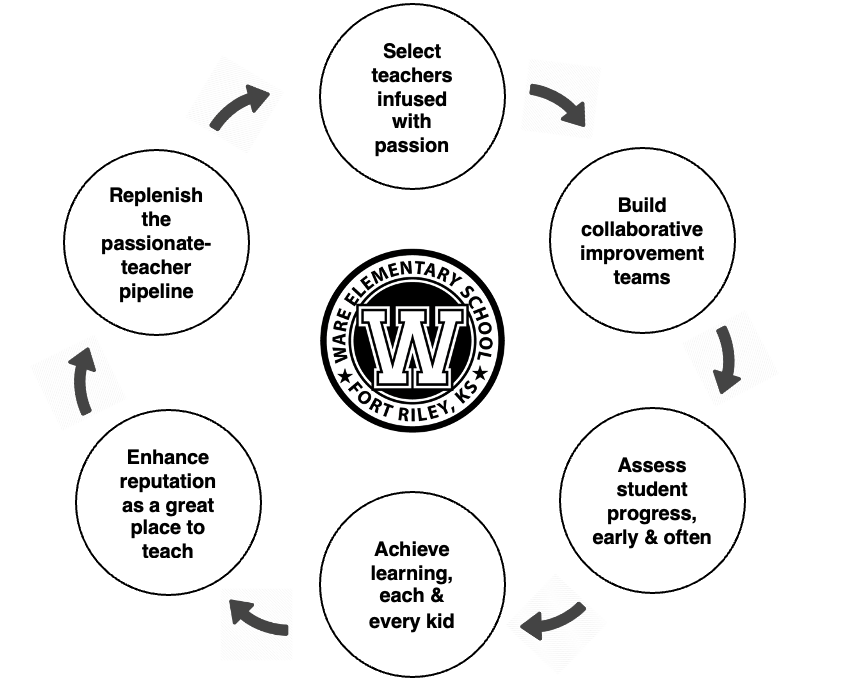Why Every Entrepreneurial Business Needs a Flywheel
What is a Flywheel?
The Flywheel is a concept Jim Collins developed in his research for the book “Good to Great”. One of my favorite examples of a Flywheel Jim Collins provides in Turning the Flywheel: A Monograph to Accompany Good to Great is of Ware Elementary School, a school on a military base.
Source: Turning the Flywheel: A Monograph to Accompany Good to Great, Jim Collins
These 6 activities provide the leadership and staff of this school with the key activities the organization needs to excel at to achieve their vision & mission. Everything else is incidental. Such clarity is needed regardless of organization size, or if they are for profit, or nonprofit organizations.
The need to identify the drivers of long-term success through the Flywheel construct
In observing successful companies, we often incorrectly boil down their success to just one thing – that one product, that one big contract, or that one advertising campaign that led to what seems like overnight success. But when we look under the hood, we realize that for companies that achieve breakthrough success, it was a series of key ongoing activities, executed with excellence and consistently over time, that led to a ‘flywheel’ effect of strategic compound of effort. One turn of their flywheel helped build momentum for subsequent turns that were faster, yet built on the momentum gained by the earlier, slower turns.
Why entrepreneurial businesses need to clarify their Flywheel
In my experience, most leaders of entrepreneurial businesses have not realized the benefit of clarifying the value of a Flywheel for their business. To the pleasant surprise of every leadership team I have facilitated through the process, their Flywheel becomes one of their most, if not the most, significant articulation of their strategy. The top 4 reasons to clarify your Flywheel are:
#1: ‘Show, don’ tell’ your strategy to get everyone rowing in the same direction As consumers of written and visual entertainment, we often are more captivated by scenes that live out the technique of ‘show, don’t tell’ to advance a character or story. In many ways our brains are more drawn to ‘show’ rather than tell. ‘Show’ is quick, it’s tangible, yet contains a great deal of meaning. Clarifying a visual Flywheel for your entrepreneurial business is the equivalent of ‘show, don’t tell your strategy’. Visionary entrepreneurs often intuitively get the strategy of their business but have difficulty conveying what’s in their head to everyone else. A great Flywheel first gets your leadership team on the same page about the true strategy of the business, and then can be used to get everyone else understanding and aligning around the strategy of the business.
#2: Daily focus Entrepreneurs face a daily whirlwind of demands, tasks, fires, and opportunities. It is often difficult to truly recognize what is most important without knowing the five to seven most important drivers of business momentum. Having a Flywheel allows Visionaries (CEOs) and Second-in-Command (COOs) to focus the overall efforts of the business, while functional leaders can see how their function fits into the overall strategy of the business. Therefore, the Flywheel can become a way to assess the use of time and other limited resources and helps leaders answer the question ‘will this investment of time or other resources help our Flywheel spin faster?’. What do I need to stop doing, so as I can start doing an activity that will make our Flywheel spin faster?
#3: Longer term focus to increase the value of your business To grow the value of your business generally some combination of growing the top line and bottom line will lead to 5X+ increase in the value of your business. For leadership teams who have articulated their Flywheel, their Annual and Quarterly Planning results in Goals and Rocks that are aligned with the few most important annual and quarterly priorities that will increase the value of the business. The Flywheel becomes a filter to say “yes” to what the few most important priorities, and to say “no” to the rest.
#4: Align the business’ internal activities and market realities Flywheels have a combination of the internal activities your business must excel at, along with the activities you must get right in the marketplace. Flywheels help teams see the connection between those behind the scenes and market facing activities, and how both are essential to grow your business profitably.
A picture that paints a thousand words
Visual representations of Core Values are a frequent sight in offices. But imagine having a visual representation of your strategy that all your employees can be reminded of daily, that helps them see how their decisions and actions lead to the ultimate success of the business. Your business would be better for it!
About the Author
Tom Barrett is a Leadership Team Coach based in Nashville, and is a Certified Scaling Up Coach™, Certified Pinnacle Business Guide, & former Certified EOS Implementer™. He helps his clients build scalable businesses by clarifying their vision, simplifying their strategy and achieving their goals one quarter at a time.

